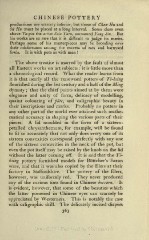Page 445 - Oriental Series Japan and China, Brinkly
P. 445
CHINESE POTTERY
productions are scarcely inferior, but those of Chan Hu and
Sti Hu must be placed at a long interval. Some class even
above Ta-pin the artist Saio Yuen, surnamed Tang Sin. But
his works are so rare that it is difficult to judge its merits.
Perhaps some of his masterpieces may be brooding over
their misfortunes among the excreta of rats and barnyard
fowls. It is with pots as with men !
The above treatise is marred by the fault of almost
all Eastern works on art subjects : it is little more than
a chronological record. What the reader learns from
it is that nearly all the renowned potters of Ti-hsing
flourished during the last century and a half of the Ming
dynasty ; that the chief points aimed at by them were
elegance and unity of form, delicacy of modelling,
quaint colouring of pate, and caligraphic beauty in
their inscriptions and marks. Probably no potters in
any other part of the world ever attained such mathe-
matical accuracy in shaping the various parts of their
Apieces.
lid moulded in the form of a sixteen-
petalled chrysanthemum, for example, will be found
to fit so accurately that not only does every one of its
sixteen convexities correspond perfectly with any one
of the sixteen concavities in the neck of the pot, but
even the pot itself may be raised by the knob on the lid
without the latter coming off. It is said that the Ti-
hsing pottery furnished models for Bottcher's Saxon
ware, and that it was also copied by the Elers at their
factory in Staffordshire. The pottery of the Elers,
however, was uniformly red. They never produced
any of the curious tints found in Chinese boccaro. It
is evident, however, that some of the beauties which
the latter possessed in Chinese eyes can scarcely be
appreciated by Westerners. This is notably the case
with caligraphic skill. The delicately incised diapers
363

